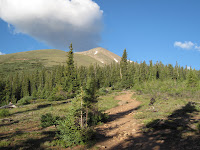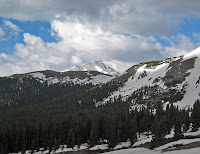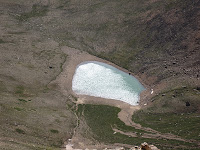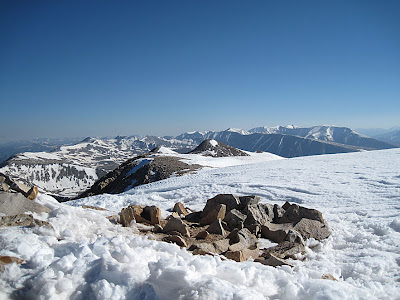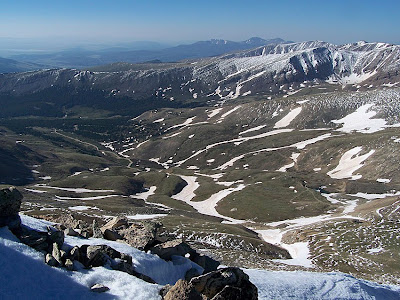INTRODUCTION
Independence…. The word conjures up notions of patriotism, revolution, the American Dream. Since 1776 Americans have claimed the word as if it was our own creation. To me, however, at least for one weekend, the word came to mean something entirely different. It meant sandstone, pitons, and exposure. Off-widths, overhangs, and, of course, Otto.
It is October in an election year. Everyone wants to talk about politics. Some might say that this is an especially important election, a crucial and vital turning point for our country. Now I won’t say “I don’t care”, even though I might be tempted some days, but I will say that during this election season my mind has been a bit distracted, and the importance of the perpetual Elephant vs. Donkey boxing match has fallen a distant second to my final push to get as much rock and alpine climbing in as possible before Old Man Winter brings his inevitable complications. Next on our list was a climb we had been looking at for awhile: Independence Tower.
A BRIEF HISTORY
Otto’s Route is a classic of American Rock Climbing. While some may say that the climbing on Otto’s Route is too sandy, gnarled and unnatural to be even considered on the same level as other desert tower classics like Castleton, the Priest, or the Fisher Towers, I believe that the route’s unique history makes it more appealing rather than less.
In 1911 a man named John Otto chopped steps and drilled pockets for artificial pipe holds on the west side of the formation. On Independence Day he completed the climb donning cowboy boots and erected an American Flag on its summit. Now John Otto loved this monument. It is hard to judge him today by modern standards when over a hundred years have now passed since his accomplishment. To this day I know people that refuse to climb this route because it is “chipped”. But it’s not like some unworthy climber hacked their way up it by moonlight in the mid 1990’s, Otto’s Route is a rare example of very early North American rock climbing history.
PREPARATIONS
My girlfriend Ella and I decided to make a base camp in Grand Junction, Colorado for a four-day climbing stint culminating in our attempt of Independence Tower. My old college roommate lived in Grand Junction, and with a little libation-related bribery, we convinced him to host our Fall weekend in the desert.
The first day we thought we would warm-up with a little bouldering at a small but well-featured bouldering area just outside of Grand Junction on the border of the Colorado National Monument. This area, known as “Dynamite Shacks”, is home to several area classics, but the best and most famous is an amazingly shaped rock called the Millennium Falcon with a namesake problem that is probably the best juggy roof problem I have ever seen.
|
|
On the second day we decided to step it up and headed up to Unaweep to do some trad climbing. Unaweep is one of my favorite granite playgrounds. I am especially fond of it because of sentimental attachment. While I won’t say “I learned to climb there” (I am still learning to climb), it is where I did some of my first climbing. First on top rope, then later I did my first trad lead there. On this trip we headed to the Sunday Wall. Joined by friends, we decided to spend a relaxing day climbing single pitch.
After taking turns leading a few pitches we packed up our gear and drove down to Nine Mile Hill to spend the rest of our forearms bouldering in Unaweep’s vast fields of Dakota and Burro Canyon sandstone boulders.
On day 3, it seemed like a good idea to get back into sandstone, so we started up Monument trail to climb the Lower Monument Canyon slabs, a fun set of slabby dihedrals and face climbs. We were joined again by a group of friends, this time bringing our number up to five. Sandstone is one of my favorite types of rock. We climbed Luhr’s Route (5.8), First Dihedral (5.8), and onsighted a slabby sport climb just to the right called Circle, Square, and Triangle (5.10a). With five people, it took the better part of the afternoon shuttling each of us up, reloading for each climber to have their shot at leading. As the sun set after a perfect fall day in the high desert, we decided to finish off the rest of our forearms back at the Dynamite Shacks’ boulders.
|
| ||||
|
|
THE CLIMB
I was awake early with excitement, and after breakfast we made our way back to the Lower Monument Canyon trailhead for the climb. Not long after starting the hike, we encountered a Bighorn Sheep ram and accompanying harem at very close range. We snapped a few pictures and continued, excited by this excellent omen. A great start to what we hoped was going to be a great day.
It is a two and a half mile approach to the Tower, and with a backpack laden with a full trad rack and a stomach with two cups of dark coffee, we arrived at the base of the climb with our hearts hammering in our chests and sweat dripping from our brows. I made the decision to leave my long sleeve shirt behind in my backpack at the route’s base.
|
|
Ella and I had struck a deal. She was anxious about the exposed and overhanging crux on pitch 4, so I offered to lead it as long as she battled through the off-width crux of pitch 2. She had just sent a gnarly off-width at the Sunday Wall called Three’s Company two days earlier. While no Pamela Pack, her dexterous climbing style has allowed her to fight through gnarly and awkward off-widths that battered and/or rejected me. Also joining us for the climb was a sport-climbing friend of ours who, having no experience with trad gear or with multi-pitch, was relegated to following and carrying the backpack (something he grumbled about more than once).
Having sorted out the logistics and affixed all the cams, slings and caribiners to my harness that I could possibly need on the climb, I called out “On Belay?” and having received a satisfying answer, took a deep breath and started up the first pitch.
 |
| Starting Pitch 1 |
Since Otto’s Route is almost entirely in the shade, and it being October, I quickly regretted leaving my long-sleeve behind. By the time all three of us had climbed and were on the belay ledge I was cold.
Next up was the off-width. It loomed ahead looking a bit ugly. Ella took the sharp end and started up an easy ramp leading to the bottom of the most difficult part. The off-width, as it t urns out, is not as bad as it looks. Though there was some groveling and thrutching and swearing, Ella found Otto’s chopped holds and pulled through without undue troubles. She belayed us up to the ledge.
Otto’s Route is a friendly multi-pitch in the sense that all the belays are on huge ledges, often big enough to feel quite comfortable de-roping. We coiled our ropes here and passed through a skinny passage known as the Time Tunnel, which was narrow enough that I had to shift sideways to get my shoulders through.
|
|
|
|
No Falls mode is familiar to anyone who climbs class 3 or above in the alpine realm. Knowing that any slip, any mistake at all, could cost you very dearly, perhaps even with your life, is part of adventure climbing and mountaineering. It is not that we venture to these places recklessly with some sort of “death wish”, as some might believe. To me it is more the experience of the total focus and confidence you can achieve when placed in such a situation that requires such utter control. For every accomplishment there is risk. Without the risk and without achievement, there is no going forward. Or in this case, up….
In reality, it didn’t take long to climb the fifty feet of ~5.3 to the first piton. And although the exposure is intense, with 400 feet of air on both sides, when you focus on your climbing you don’t really notice it. The climbing became steeper after the piton. Otto’s drilled pockets, however, were always present right where you needed them. And the worn chipped steps provided decent, albeit slippery, footholds. Resting on a pocket, I made an easy clip of the second piton. Although the crux move was still ahead, the fall potential was basically controlled on the overhanging terrain. Moving up on insecure feet, I clipped the final piton, hesitated a moment, and made an airy and excellent move to the final ledge and pulled the overhang with confidence. I heard Ella and Manik cheer below.
|
|
|
|
 |
| One last move for freedom |
Story by: Brian Wright
Photos: Brian Wright, Manik Johnson
Visit THE ARCHIVE: A list of most of our articles sorted by department
Copyright notice: This website and all its contents are the intellectual property of www.coloradomountaineering.com and its authors. None of the content can be used or reproduced without the approval of www.coloradomountaineering.com.
Climbing and mountaineering are dangerous!! Please see the DISCLAIMER page
For information about how to contact us, visit this link
Visit THE ARCHIVE: A list of most of our articles sorted by department






















.jpg)









